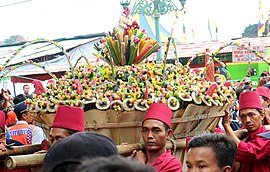
Gamelan is the traditional ensemble music of the Javanese, Sundanese, and Balinese peoples of Indonesia, made up predominantly of percussive instruments. The most common instruments used are metallophones played by mallets and a set of hand-played drums called kendhang/Kendang, which register the beat. The kemanak and gangsa are commonly used gamelan instruments in Bali. Other instruments include xylophones, bamboo flutes, a bowed instrument called a rebab, a zither-like instrument siter and vocalists named sindhen (female) or gerong (male).

Central Java is a province of Indonesia, located in the middle of the island of Java. Its administrative capital is Semarang. It is bordered by West Java in the west, the Indian Ocean and the Special Region of Yogyakarta in the south, East Java in the east, and the Java Sea in the north. It has a total area of 34,337.48 km2, with a population of 36,516,035 at the 2020 Census making it the third-most populous province in both Java and Indonesia after West Java and East Java. The official estimate as at mid 2022 was 37,032,410. The province also includes a number of offshore islands, including the island of Nusakambangan in the south, and the Karimun Jawa Islands in the Java Sea.

Imogiri is a royal graveyard complex in Yogyakarta, in south-central Java, Indonesia, as well as a subdistrict under the administration of Bantul Regency. Imogiri is a traditional resting place for the royalty of central Java, including many rulers of the Sultanate of Mataram and of the current houses of Surakarta and Yogyakarta Sultanate. The name Imagiri is derived from Sanskrit Himagiri, which means 'mountain of snow'. The latter is another name for Himalaya.

Old Banten is an archaeological site in the northern coast of Serang Regency, Banten, Indonesia. Located 11 km north of Serang city, the site of Old Banten contains the ruin of the walled port city of Banten, the 16th-century capital of the Sultanate of Banten.
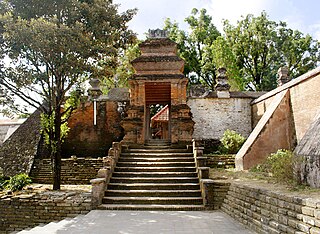
Kotagede is a city district (kemantren) and a historic neighborhood in Yogyakarta, Special Region of Yogyakarta, Indonesia. Kotagede contains the remains of the first capital of Mataram Sultanate, established in the 16th century. Some of the remains of the old Kotagede are remains of the palace, the royal cemetery, the royal mosque, and defensive walls and moats. Kotagede is well known internationally by its silver crafting.

A kyai is an expert in Islam, usually used among the ethnic Javanese people.

Yogyakarta is the capital city of Special Region of Yogyakarta in Indonesia, in the south-central part of the island of Java. As the only Indonesian royal city still ruled by a monarchy, Yogyakarta is regarded as an important centre for classical Javanese fine arts and culture such as ballet, batik textiles, drama, literature, music, poetry, silversmithing, visual arts, and wayang puppetry. Renowned as a centre of Indonesian education, Yogyakarta is home to a large student population and dozens of schools and universities, including Gadjah Mada University, the country's largest institute of higher education and one of its most prestigious.

The Gamelan Sekaten is a ceremonial gamelan from central Java, Indonesia, played during the annual Sekaten festival. The word "sekaten" itself is derived from syahadatain or shahada, the first requirement for converting into Islamic faith. Traditionally it is played once per year, on the occasion of Mawlid, Muhammad's birthday, for the week from the 6-12 of the month of Mulud. On this celebration it is brought from the palace at 11 pm to two pavilions before the Great Mosque. It is played every day during that week except the Thursday night/Friday morning. On the eve of the birthday proper, it is returned at 11 pm.

Javanese culture is the culture of the Javanese people. Javanese culture is centered in the provinces of Central Java, Yogyakarta and East Java in Indonesia. Due to various migrations, it can also be found in other parts of the world, such as Suriname, the broader Indonesian archipelago region, Cape Malay, Malaysia, Singapore, Netherlands and other countries. The migrants bring with them various aspects of Javanese cultures such as Gamelan music, traditional dances and art of Wayang kulit shadow play.

The Royal Palace of Yogyakarta is a palace complex in the city of Yogyakarta, Yogyakarta Special Region, Indonesia. It is the seat of the reigning Sultan of Yogyakarta and his family. The complex is a center of Javanese culture, and contains a museum displaying royal artifacts. It is guarded by the Yogyakarta Kraton Guards.

Javanese dance is the dances and art forms that were created and influenced by Javanese culture in Indonesia. Javanese dance movement is controlled, deliberate and refined. Javanese art often displays a finesse, and at the same time a serene composure which is elevated far above everything mundane. Javanese dance is usually associated with courtly, refined and sophisticated culture of the Javanese kratons, such as the bedhaya and srimpi dance. However, in a wider sense, Javanese dance also includes the dances of Javanese commoners and villagers such as ronggeng, tayub, reog, and jaran kepang.
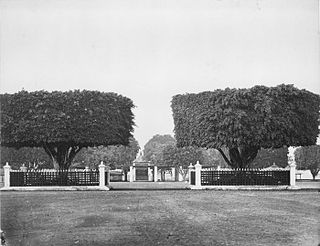
An alun-alun is a large, central, open lawn square common to villages, towns and cities in Indonesia.

Surakarta Sunanate is a Javanese monarchy centred in the city of Surakarta, in the province of Central Java, Indonesia.

Wajik or wajid, also known as pulut manis, is a traditional glutinous sweet made with rice, sugar and coconut milk. It is an Indonesian kue, and a kuih of Brunei, Singapore and Malaysia.
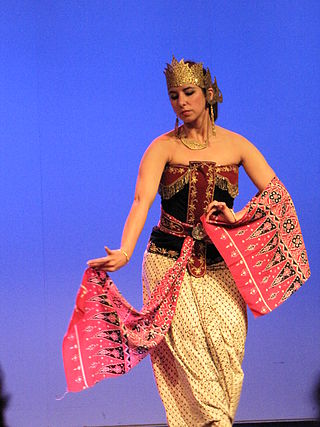
The Srimpi is a ritualised dance of Java, Indonesia, associated with the royal palaces of Yogyakarta and Surakarta. The srimpi dance is one of the classical dances of Central Java. Along with the bedhaya, srimpi epitomised the elegant character of the royal Javanese court, becoming a symbol of the ruler's power as well as the refinement of Javanese culture.

Kauman Great Mosque, approximate English translation of Javanese Mesjid Gedhe Kauman is a Great Mosque of the Yogyakarta Sultanate in Java, Indonesia. It is located to the west of the North Alun-alun of Yogyakarta Kraton.

The Great Mosque of Surakarta is an 18th-century Javanese mosque in Surakarta, Central Java, Indonesia. It is the royal mosque of the Surakarta Sunanate.
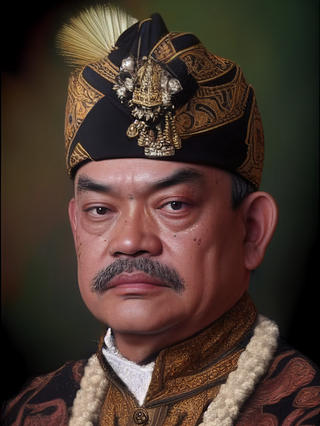
KGPAA Paku Alam X is the Duke (Adipati) of Pakualaman, a small Javanese duchy in the Special Region of Yogyakarta, Indonesia. He succeeded as Paku Alam upon the death of the previous ruler, his father Paku Alam IX, who died on 21 November 2015. He was formally crowned with the Royal Javanese title of Kanjeng Gusti Pangeran Adipati Arya (KGPAA) Paku Alam X on 7 January 2016, and as stated in the National Constitution, on 25 May 2016, He was sworn and appointed as the hereditary Vice-Governor of Yogyakarta Special Region.

The Yogyakarta Kraton Guards are the contingents of soldiers guarding the Kraton Ngayogyakarta Hadiningrat, the official residence of the Sultans of Yogyakarta. They serve ceremonial and security functions. By tradition, the reigning Sultan of Yogyakarta serves as Colonel-in-chief of the Guards.

The Pura Mangkunegaran is a palace complex in the city of Surakarta, Central Java, Indonesia. It is the official palace and residence of the Duke of Mangkunegara and his family. The palace complex is one of the centers of Javanese culture and contains a museum exhibiting royal artifacts of Mangkunegaran.
